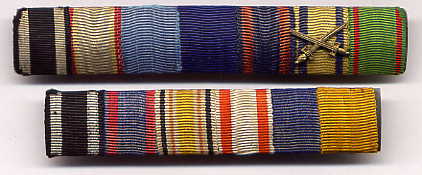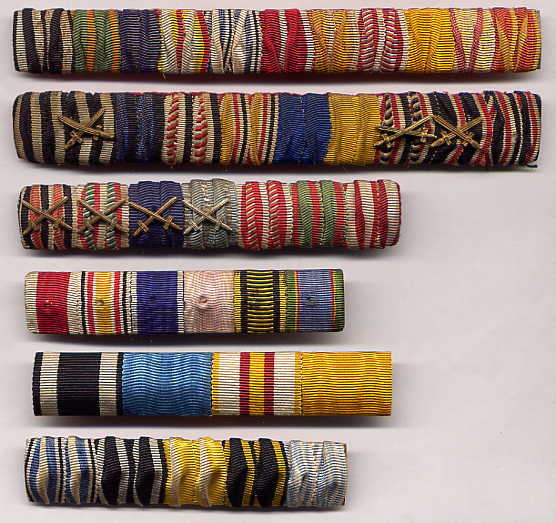
Content - Richard Lundström
Layout - Sebastian Bianchi
The Weimar Republic
The new German Republic was explicitly hostile to awards and for the 15 years of its existence, the Weimar Republic failed to impose any sort of precedence regulations. The army-the Reichsheer- insisted on still following the old ways, and succeeded in maintaining a sort of continuation of the Imperial system. The navy- the Reichsmarine- was far more lackadaisical, and allowed a number of the unofficial vanity/veterans' self-awarded pieces to be worn in uniform. It is usually impossible to distinguish an Imperial period army ribbon bar from a Weimar one, unless it is a tab back type with the bright, nickel finished metal parts that replaced the Feldgrau painted variety in the 1920s or early 1930s.
Here are two Reichsmarine bars.

The upper bar belonged to Konteradmiral Kehrhahn, whose decision to place his combatant Oldenburg Friedrich August Cross after his XXV years Service Cross just ahead of his pre-WW1 Swedish and Turkish Orders cannot be logically explained. The lower bar shows a 1900-1901 Boxer Rebellion campaign medal for China ahead of both a Red Eagle Order and an Imperial Long Service XXV-when regulations until the late 1930s would place such a war medal behind the long service award.
This fine Saxon bar also shows the prevailing any-which-way of the Roaring Twenties.

RV
Here again we see the absurdly popular, pointless mini EK, and note the double Prussian Red Cross ribbons for 2nd and 3rd Class Medals, here sandwiching another Oldenburg FAC (what was it about this specific award that led it to be so casually tossed into groups?…), and ending with the ribbon for the Turkish War Medal star.
Here are a variety of typically eccentric Weimar ribbon bars. We'll take these one at a time for describing the non-regulation aspects.

TP
The top bar belonged to char. Oberstleutnant aD Richard Fischer, of Baden Infantry Regiment 114 in 1914. The South German style was so popular it was all but universal in Baden, Hohenzollern, Württemberg, and Bavaria. Peculiarly-given the extra cost for the doubled ribbons and hand labor, Fischer chose NOT to mount any devices on any of these ribbons. The awards are: Prussian Iron Cross 2nd Class, Baden Order of the Zähringen Lion (which he received in Knight 2nd Class with Oakleaves and Swords grade on 6 October 1914 in Reserve Infantry Regiment 111), Prussian XXV Years Service Cross (Prussian long service awards were suspended during the war, and war years counted double for regulars-this would have been given to him on discharge in March/April 1920), a Mecklenburg war decoration (Schwerin and Strelitz both used this ribbon), Bavarian Military Merit Order (4th Class with Swords received 14.12.14), Hessian Order of Philip the Generous (pre-WWI peacetime Knight 2nd Class-the pale blue edges have faded as usual but are visible on the reverse), Lippe-Detmold War Honor Cross (Fischer ended the war as Commander of Inf Rgt 158 in Lippe's VIIth Corps area), Austro-Hungarian war award (obviously a Military Merit Cross 3rd Class which would normally have had a round gold War Decoration device), 1897 Wilhelm I Centenary Medal, Baden Friedrich-Luise Medal of 1906+ , and Baden 1902 Jubilee Medal. This bar is in neither Reichs nor war-then-peace order, throwing non- Prussian/Baden war decorations after the long service cross in semi-Reichs precedence, but mingling his peacetime Order among war awards, and inserting the foreign Habsburg cross before his German commemorative medals. Since Fischer died 9 December 1923, we can date this typical mishmash April 1920-December 1923.
The second bar consists of the 1914 Iron Cross, what presumably is a Prussian Crown Order 4th Class on combatant war ribbon with Swords for a colonial campaign, the 1825-1913 Prussian/Navy IX Years Service Brooch ribbon (indicating a technical or administrative type who rose through the NCO or PO ranks), 1904-1906 Southwest-Africa war medal, 1900-1901 China war medal, another Prussian Long Service award (either XXV Years as a regular or perhaps either Reserve-Landwehr award?), the 1897 Centenary Medal, and three 1920s veterans awards. The ONLY way that both long service awards could have been worn together is if the solid blue one was a Reserve-Landwehr medal or cross. If it was the XXV Years Service Cross, that would have replaced the IX bar, not been worn in addition to it. The three veterans organization awards at the end were not official, and would have been replaced in 1934 by the Honor Cross of the World War aka Hindenburg Cross.
The third bar is actually the second row of a two row group whose upper row was separated from this half. An unidentified veterans award precedes the official (1928+) Hungarian WWI Commemorative Medal for Combatants (available to Germans simply on application), then the 1920s Austrian Ehrenlegion veterans cross (note bronze swords on what would otherwise look like a Prussian long service ribbon), a Bulgarian Bravery award, Austro-Hungarian war award, Turkish Osmanie Order, and Turkish War Medal star. Another "anything goes" jumble: the official war decorations should have preceded the peacetime Turkish Order and Hungarian campaign medal, yet even the unofficial Austrian veterans cross has been mounted ahead of those. A plain Austro-Hungarian war ribbon like this would normally indicate an enlisted man's Bravery Medal-yet the Osmanie Order was rarely given to ranks below Captain, so the Austrian WWI award must have been either the usual MMC (without a device) or a Franz Joseph Order on war ribbon. This is such an odd group that the upper row, now missing, might have identified the original owner (see Luftwaffe surgeon general Koschel's double row of ribbons in the Third Reich section following).
Fourth-- another strange combination that would only be explained by the recipient's award documents. The 1922+ German Red Cross Decoration is followed by 1900-1901 China Boxer Rebellion medal, then the 1825-1913 Prussian/Navy XV Years Service Bar (as with the second bar above, most recipients updated their award to the cross and medals of M1913), Bavarian Cross for Voluntary Nursing Service, Austrian 1873 War Medal (awarded for campaigns 1848-1901 and given to Germans attached to the miniscule Habsburg forces in China), and Siamese Crown Order (probably for a medal grade, here). This man, whether he was a naval Petty Officer or an army NCO, was not in service in March 1897, nor did he remain in active duty through WWI or his XV would have been replaced by an XXV. Overseas service counted double, so presumably he did his 12 years career enlistment and went into civil life before WWI. Absence of any possible WWI award (except the Bavarian Cross) indicates he might have still been in China as a civilian. No Honor Cross may date this bar before 1934-or he simply was not entitled to one if a civilian during the World War. Note here that the normal holes stamped in every spot for devices were punched through back to front instead of front to back, causing the ribbon wear which makes it appear that devices have been removed. From ca 1930, most ribbon bars had these holes punched through, a subject that will be detailed in the Construction Section.
Fifth bar: a 1914 Iron Cross is followed by the pale blue ribbon of either a Prussian Crown Order or Württemberg Friedrich Order. What follow are the Spanish Military Medal (created 1918) and not the 1897 Centenary Medal, but (in this precedence, and based on the 3rd ribbon), the Spanish Melilla Medal for 1920s Rif Campaign. The owner must have joined the lesser known Spanish Foreign Legion after WWI. It was a period where such odd groups were possible.
Bottom bar in typical South German style is a Bavarian Military Merit Order/Cross (undoubtedly the 3rd Class Cross, without bronze swords device-often devices were not used to blur class distinctions), Prussian 1914 Iron Cross (this is correct precedence for a Bavarian. Saxons also wore their awards first as an independent Kingdom. Württembergers waffled back and forth between asserting superiority or going with Prussian awards first.), a 1919 Silesian eagle 2nd Class for Freikorps service, the unofficial 1932 dynastic Jubilee Medal for former members of Bavarian Infantry Regiment 2, and a Bavarian Long Service award. This ex-NCO could only have worn this bar for about 2 ½ years, since there is no Hindenburg Cross
![]()
© Copyright Wehrmacht-Awards.com LLC |